Seventh chords are a vital part of contemporary music but can be challenging to understand and master, particularly for beginners.
But, with the right instruction, they can be grasped quickly and incorporated into your playing. This guide will teach you everything you need to know about 7th chords, including how to play them on the guitar, how they sound, and how to use them in your music.
Introduction to Seventh Chords
Seventh chords are a type of chord that includes four distinct notes; hence, they are known as quadads. Since an extra note is added to the triads, these four-note chords are more complicated and may be considered extended triads. This extension is usually by another 3rd interval to form a 7th of some type above the root note.
There are five major types of seventh chords: major seventh, minor seventh, dominant seventh, & full and half-diminished seventh chords. Each type of chord has a unique sound that can be used in various musical situations. If nothing else is explicitly stated, the term seventh chord usually means the dominant seventh chord.
A quadad harmony is more sophisticated and complex as more notes clash. Quadads are used in virtually all genres, particularly jazz and blues music.
History of the Seventh Chord
The use of the seventh chords started during the Renaissance and Baroque periods when they were used in cadences. However, they were considered unorthodox and dissonant and used solely as a nonchord tone or embellishments. Their destabilizing effect on the triad provided the composer with an opportunity to take the movement in any given direction.
Slowly the musicians and the audiences became accustomed to the dissonance, and the seventh chords were accepted as part of the common music. Now, almost every chord in jazz is a seventh chord.
Classification of Seventh Chords
There are various methods to classify the seventh chord. Some popular books use the type of the triad followed by the type of the seventh interval to name these chords.
Naming Conventions
For example, the major triad followed by a minor seventh is called a major/minor seventh chord. If the triad quality matches with the seventh type, which means both are either major, minor or diminished, you can use a shortened name. So, if the major triad is followed by a major third interval, the chord is referred to as the major seventh chord.
This method is not used for augmented/augmented chords as these chords are not common. You can, however, use it for augmented/minor chords. A dominant chord is a major/minor chord, while a half-diminished one is a diminished/major one.
When the type is not explicitly specified, the triad is assumed to be a major triad and the seventh a minor interval.
Tertian Chords
As you may be aware, the chords built with only the major and minor third intervals are known as the tertian chords. Any 7th chord has three-third intervals, each of which can be a major or minor third. So, there are 8 possible combinations of tertian 7th chords in Western music.
The below table shows six out of them, starting with major, diminished, or a minor triad. Each of these triad types is followed by a major or minor seventh. As stated earlier, the augmented triad is not commonly used and hence not shown in this table. In addition, the minor/major seventh is also rarely used, leaving you with the five critical 7th chords, as highlighted earlier.

Non-Tertian Chords
In addition to the tertian chords, there are other seventh chords that are constructed using the augmented/diminished thirds. These chords are many in number, but very few are used in Western music in non-tertian harmony.

Major Seventh Chords
As stated earlier, the major seventh chords are formed by stacking a major third interval over a major triad. It is also called the major/major seventh chord. Since a major triad has a Perfect fifth, seven semitones away from the root, and a major 3rd interval has four semitones, the major seventh chord has the 7th interval, 11 semitones away from the root note. The intervals and notes of Major 7th chords are
R – M3 – N2 (M3) – m3 – N3 (P5) – M3 – N4 (M7), where
- N2 is the 2nd note in the chord at the Major 3rd interval.
- N3 is the 3rd note in the chord at the perfect 5th interval.
- N4 is the 4th note in the chord at the Major 7th interval.
A Major 7th chord has the Chord Formula: [1 3 5 7]. So, in the key of C, the notes of the CMaj7 or CM7 chord will be {C, E, G, B}. These notes are on the major scale’s 1st, 3rd, 5th, and 7th scale degrees (SD). They are used in romantic ballads and soul music and are represented by either chord symbols: Cmaj7 or CM7 or C∆7 or C∆.
In our article on the “D Major Scale,” we explained to you that harmonizing any major scale gives three major chords (I, IV, V), three minor chords (ii, iii, vi), and one diminished chord (vii°).
| Scale Degrees | 1 | 2 | 3 | 4 | 5 | 6 | 7 |
|---|---|---|---|---|---|---|---|
| Chord Designation | I | ii | iii | IV | V | vi | viidim |
| Scale Degree Names | Tonic | Super-Tonic | Mediant | Sub-Dominant | Dominant | Sub-Mediant | Leading Tone |
| Chord Names | D | Em | F#m | G | A | Bm | C#dim |
| Chord Quality | Major | minor | minor | Major | Major | minor | dim |
Building Major 7th Chords
The major seventh chords are formed using the major triads at SD 1 (known as the tonic triad) and SD 4. The major triads at scale degree 5 lead to the dominant seventh chords, as we will see later.
For scale degree one, the notes of the C major 7th chord in the key of C major are {C, E, G, B}. Similarly, for scale degree four, the notes are {F, A, C, E}.
The below diagrams show the Maj7 chords in Open positions.
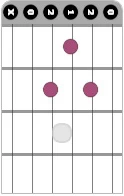
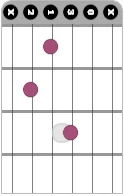
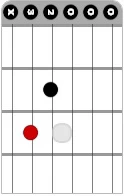
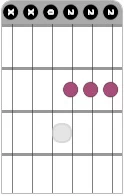
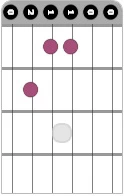
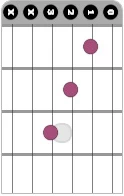
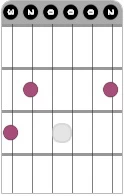
Minor Seventh Chords
Minor seventh chords are built by stacking a minor 3rd interval over a minor triad. For this reason, it is also called the minor/minor seventh chord. The 7th is 10 half steps away from the root.
The intervals and notes of minor 7th chords are
R – m3 – N2 (m3) – M3 – N3 (P5) – m3 – N4 (m7), where
- N2 is the 2nd note in the chord at the minor 3rd interval from the root.
- N3 is the 3rd note in the chord at the perfect 5th interval from the root.
- N4 is the 4th note in the chord at the minor 7th interval.
A minor 7th chord has the Chord Formula: [1 b3 5 b7]. The notes of the C minor 7 or Cm7 chord will be {C, Eb, G, Bb}. These notes are on the corresponding minor scale’s 1st, 3rd, 5th and 7th scale degrees (SD). They are used in pop, R & B music and are represented by either chord symbols: Cmin7 or Cm7 or C-7.
Building Minor 7th Chords
As stated above, the minor basic triads are formed from any major scale’s 2nd, 3rd, and 6th scale degree. Consider the seventh chords built with these degrees (Notes D, E, and A) of the C major scale, as shown below.
Dm7: D – m3 – F – M3 – A – m3 – C = {D, F, A, C}
Em7: E – m3 – G – M3 – B – m3 – D = {E, G, B, D}
Am7: A – m3 – C – M3 – E – m3 – G = {A, C, E, G}
The below diagrams show the min7 chords in Open positions.
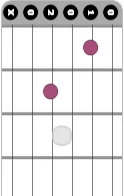
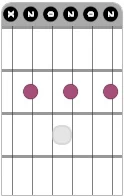
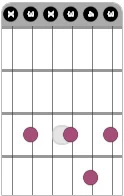
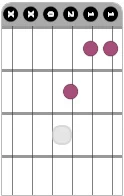
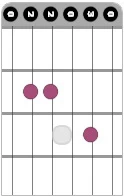
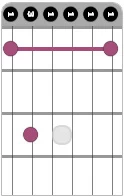
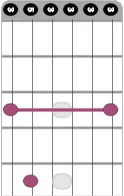
Dominant Seventh chords
A dominant seventh chord comprises a minor third interval stacked over a major triad. These are also called the Major/minor seventh chords. In these chords also, the 7th is 10 half steps away from the root like the minor sevenths.
The intervals and notes of Dominant 7th chords are
R – M3 – N2 (M3) – m3 – N3 (P5) – m3 – N4 (m7), where
- N2 is the 2nd note in the chord at the major 3rd interval from the root.
- N3 is the 3rd note in the chord at the perfect 5th interval from the root.
- N4 is the 4th note in the chord at the minor 7th interval.
A dominant 7th chord has the Chord Formula: [1 3 5 b7]. The notes of the C dominant 7 or C7 chord will be {C, E, G, Bb}.
They are used in Jazz music, Blues, Latin, Bluegrass, and Pop music and are represented by the chord symbol: C7. Even though they appear similar to the major and minor seventh, the dominant sevenths work differently by adding tension due to the tritone’s presence, which tends to resolve in the chord progression.
Building Dominant 7th Chords
As you may be aware by now, the dominant 7th chords are formed from the fifth scale degree of a major scale. Consider the seventh chord built with note G (fifth degree) of the C major scale, as shown below.
G7: G – M3 – B – m3 – D – m3 – F = {G, B, D, F}
The below diagrams show the Dominant 7 chords in Open positions.
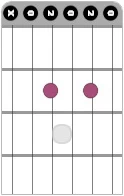
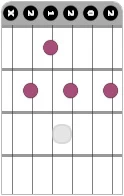
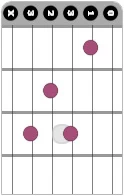
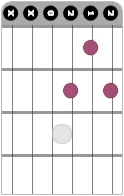
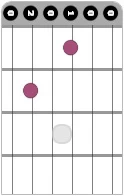
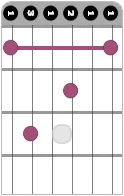
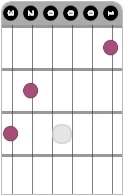
Half Diminished Seventh Chord
The half-diminished seventh chords are formed by a diminished triad followed by a major 3rd interval. These are also called diminished/major 7th chords. Like the minor and dominant 7th chords, these chords have the seventh interval, 10 semitones away from the root.
The intervals and notes of the half-diminished 7th chords are
R – m3 – N2 (m3) – m3 – N3 (dim5) – M3 – N4 (m7), where
- N2 is the 2nd note in the chord at the minor 3rd interval from the root.
- N3 is the 3rd note in the chord at the diminished 5th (tritone) interval from the root.
- N4 is the 4th note in the chord at the minor 7th interval.
A half-diminished 7th chord has the Chord Formula: [1 b3 b5 b7]. The intervals of this chord are opposite to those of the dominant 7th chords. If you look carefully, this is a minor seventh chord with a flat fifth. Hence, it is also designated as a minor 7b5 chord.
The notes of the C minor 7b5 or Cm7b5 chord will be {C, Eb, Gb, Bb}.
These chords have been used in Western music for centuries and even in the compositions of Bach, Chopin, and Mendelsohn. These are unique-sounding and melancholic chords used in jazz, blues, and musical theatre.
These chords are represented as Cm7b5, CΦ, C-7b5
Building Half-diminished 7th Chords
The half-diminished 7th chords are formed from the seventh scale degree of a major scale or the second degree of a minor scale. Consider the seventh chord built with note B (seventh degree) of the C major scale, as shown below.
Bm7b5: B – m3 – D – m3 – F – M3 – A = {B, D, F, A}
The below diagrams show the Minor 7b5 chords in Open positions.
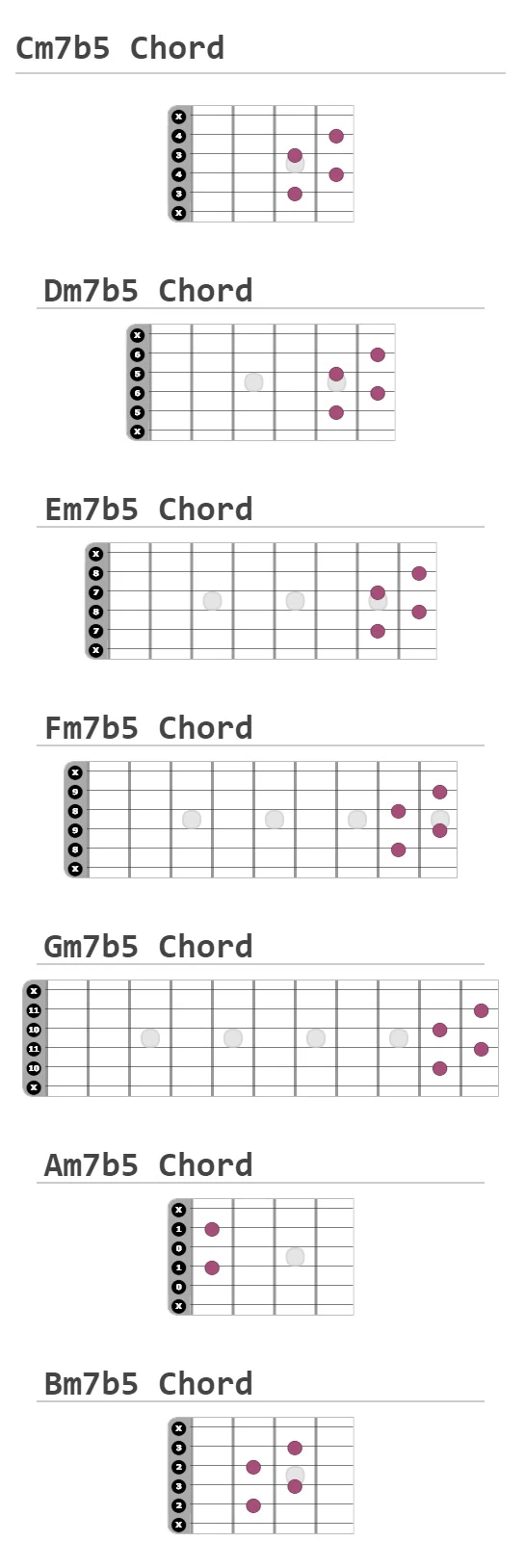
Fully Diminished Seventh Chord
The “diminished 7 chords” or “fully diminished seventh chord” is formed when you add a minor third over diminished triads, resulting in a diminished seventh interval, which is a half step below the seventh in the half-diminished chord. These chords have three minor 3rd intervals stacked over the root position note. Hence the diminished seventh is 9 semitones above the root.
This gives diminished 7th chords a symmetrical structure, as all the intervals are always the same, whether you ascend or descend the pitch. If you move these chords up or down by a minor 3rd interval, the notes will remain the same, only in a different order. Practically, every note can act like a root note.
The intervals and notes of the fully-diminished 7th chords are
R – m3 – N2 (m3) – m3 – N3 (dim5) – m3 – N4 (dim7) , where
- N2 is the 2nd note in the chord at the minor 3rd interval from the root.
- N3 is the 3rd note in the chord at the diminished 5th (tritone) interval from the root.
- N4 is the 4th note in the chord at the diminished 7th interval.
A diminished 7th chord has the Chord Formula: [1 b3 b5 bb7]. The notes of C07 will be {C, Eb, Gb, A}. This four-note chord has a double flat seventh, the same as the sixth scale degree. The chord is represented by the following symbols: C07 or Cdim7 or Cm(b7)b5 or C-(b7)b5.
These chords are not very common in contemporary music but were used in the classical and romantic eras. They are used in creating various cool-sounding sequences in jazz music and as the secondary leading tone chords. Their sound is dark, unstable, and jarring but exciting enough to create dramatic effects.
Major 6th Chord
Let’s look at some non-tertian quadad chords, starting with the major 6th chord. This chord has a cool and distinctive sound, used mainly in jazz and occasionally in other genres.
They can sometimes substitute the major seventh chord or spice up the major triad if the chord is conflicting with the melody. The scenario is possible because the major seventh has its seventh note, only one semitone from the root. You must use them with care after experimenting and satisfying yourself that they sound suitable for your use.
Major 6th chords have a major second interval stacked over the major triad. Hence the sixth interval is nine semitones away from the root.
The intervals and notes of the Major 6th chords are
R – M3 – N2 (M3) – m3 – N3 (P5) – M2 – N4 (M6), where
- N2 is the 2nd note in the chord at the Major 3rd interval from the root.
- N3 is the 3rd note in the chord at the Perfect 5th interval from the root.
- N4 is the 4th note in the chord at the Major 6th interval.
A Major 6th chord has the Chord Formula: [1 3 5 6]. So in the key of major C, the notes will be {C, E, G, A}, which is C major triad {C, E, G} followed by a Major 2nd interval note A. These four-note chords are represented by the following symbols: C Major 6 or C6.
Minor 6th Chord
Minor 6th chords have a major second interval stacked over the minor triad. Hence the sixth interval is again 9 semitones away from the root.
The intervals and notes of the minor 6th chords are
R – m3 – N2 (m3) – M3 – N3 (P5) – M2 – N4 (M6), where
- N2 is the 2nd note in the chord at the minor 3rd interval from the root.
- N3 is the 3rd note in the chord at the Perfect 5th interval from the root.
- N4 is the 4th note in the chord at the Major 6th interval.
A minor 6th chord has the Chord Formula: [1 b3 5 6]. So in the key of major C, the notes will be {C, Eb, G, A}. These four-note chords are represented by the following symbols: C minor 6 or Cm6.
Augmented Seventh Chord
These are commonly used in jazz music as a substitute for the dominant seventh. As stated earlier, the augmented 7th chord is formed by adding a diminished third interval (Major 2nd) to the augmented triad. The 7th interval is at the minor 7th interval (10 semitones) from the root.
The intervals and notes of the Augmented 7th chords are
R – M3 – N2 (M3) – M3 – N3 (Aug5) – dim3 – N4 (m7), where
- N2 is the 2nd note in the chord at the Major 3rd interval from the root.
- N3 is the 3rd note in the chord at the Augmented 5th interval from the root.
- N4 is the 4th note in the chord at the minor 7th interval.
An augmented 7th chord has the Chord Formula: [1 3 5# 7]. The notes of C+7 will be {C, E, G#, Bb}. These chords are represented by the following symbols: C+7, C Aug 7, or C7 (#5).
Inversions of the Seventh Chords
Since there are three intervals in the seventh chord above the root note, there can be three inversions of these chords to give you different possibilities for voicings. These are:
- First inversion – It makes the third scale degree as the bass note.
- Second inversion – It makes the fifth scale degree as the bass note.
- Third inversion – It makes the seventh scale degree as the bass note.
Conclusion
Seventh chords are one of the most exciting and versatile chord progressions you can use in your music. They provide a lot of harmonic colors and can be used in a variety of settings. This article looked at the different types of seventh chords and how to play them on the guitar. We also took a look at some exercises that you can do to help you better understand these chords.
I hope you found this information helpful! Let me know in the comments section if you want any clarifications or have any questions. Happy practicing!

